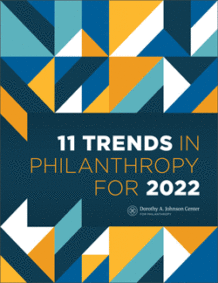Increasing Attention to the Decline in Household Giving to Nonprofits


 This article was first published in our 11 Trends in Philanthropy for 2022 report. Explore all 11 trends in the full report.
This article was first published in our 11 Trends in Philanthropy for 2022 report. Explore all 11 trends in the full report.In July 2021, data from the Philanthropy Panel Study, a long-running survey project of Indiana University’s Lilly Family School of Philanthropy, revealed that in 2018 the number of American households that said they give to charity dropped below 50% for the first time (Osili et al.). That number was 66% as recently as 2000. This decline in household giving — found in other evidence as well — is raising major alarm bells in the field.
This steady decline in giving to nonprofits is found across all racial and ethnic groups, and households headed by younger donors are even less likely to give (Osili et al., 2021). For those households that do give, the average amount given is going down for all but the wealthiest families (Generosity Commission, n.d.).1
“[I]n 2018 the number of American households that said they give to charity dropped below 50% for the first time.”
We’ve known for a while that the “wealth gap is becoming a giving gap” (Moody, 2019). The overall giving pie continues to increase — topping $324 billion for individuals in 2020 (Giving USA, 2021) — but more of that pie is contributed by fewer households (Duquette, 2020; Rooney, 2019).
That said, research from the Fundraising Effectiveness Project (2021), the Blackbaud Institute (2021), and others suggests that during the pandemic there was at least a short-term reversal of this trend — perhaps attributable to extra funds from stimulus checks as much as newly motivated donors (Albrecht, 2021). However, it isn’t clear yet if this pandemic-related giving increase was more than just a blip in this overall downward trend.
The longer-term decline in household giving is certainly troubling to nonprofits and anyone who believes that more giving by more people is a good thing. It raises the distressing possibility that the giving of “treasure” to nonprofits might eventually be something only rich people do.
The truth is we don’t really know for sure what is causing this decline. Initial indications are that the answer will be a complex one.
Wealth concentration has exploded. Disposable income has gone down for the middle and working class. Student debt has skyrocketed (Martin, 2019).
Also, several traditional facilitators of household giving have been declining, especially among young people. These include religiosity, social capital, and trust in institutions — as scholars like Robert Putnam and Shaylyn Romney Garrett (2020) have shown. Trust specifically in nonprofits has also been declining (Independent Sector, 2021; Martin, 2021).
Finally, the decline might be because giving money to nonprofits is not the only way — or even the primary way — many households believe they can make the world a better place. As Lucy Bernholz (2021) explains in How We Give Now, giving to tax-exempt organizations is just one of many options in our modern “givingscape.” Person-to-person helping, crowdfunding, political donations or activism, ethical consumption, and impact investing are becoming more popular alternatives — again, especially among young people (Cause and Social Influence, 2021).
Some might ask: If the total amount of giving to nonprofits is still going up, why should we worry if that money is coming from fewer families while others slow or stop their giving?
For starters, we know that many charities, especially smaller ones, rely heavily on a broad base of modest gifts. The Urban Institute (2021) found that nonprofits with annual budgets under $500,000 said they relied on individuals for 30% of their revenue, versus 18% for larger organizations (Faulk et al.). Smaller organizations might not have the bandwidth to adapt their fundraising practices to attract bigger donations.
“If the funding mix of any nonprofit becomes increasingly dominated by major gifts from a few supporters, what might the practical and ethical consequences be?”
There are also power dynamics to consider. If the funding mix of any nonprofit becomes increasingly dominated by major gifts from a few supporters, what might the practical and ethical consequences be? Could this trend further perpetuate the too-common misconception that philanthropy is only the domain of the wealthy? Could it create a sort of two-tiered philanthropic landscape, where those with most of the wealth are privileged enough to give in the ways we measure and celebrate, while others only give in less formal ways that go mostly unrecognized?
With these and other reasons in mind, some are now devising plans to reverse the trend.
Economic Reform
Likely the best antidote is to stop or reverse growing inequality, and/or to help alleviate the financial strains felt by those households who are giving less to nonprofits. Some funders — such as the members of Economic Opportunity Funders — and many advocacy organizations are ramping up economic reform efforts, but such a massive social transformation is a task that requires a major shift in public policy.
Tax Incentives
Some advocate using the tax code to incentivize charitable giving by a larger range of households. Groups like Independent Sector and Council on Foundations continue to call for a universal charitable deduction or tax credit at the federal level (Montañez, 2020). At the state level, there is a push to create new or expanded tax-based incentives.
Research
The most notable effort by the philanthropic sector to combat this decline is the Generosity Commission. Following an initial round of research, the Generosity Commission was formally launched in late 2021. Over the next two years, it will fund additional research to inform recommendations for reversing the decline and embracing new ways of giving, and lead a “National Conversation” about its work. While this ambitious effort is just getting started, it is already not without its critics (Daniels, 2021; Rojc, 2021).
In the end, even if we can slow or reverse this trend, it seems best if we expand our understanding of what “counts” as giving and doing good (Fidelity Charitable, 2021). There are tremendous benefits to thinking broadly about philanthropy, in a way that can include a range of informal, non-monetary, smaller, and more personal gifts and actions that might not be captured in a survey question about household giving to organizations (Payton & Moody, 2008). And in a world with increasingly blurry boundaries between sectors, it would make sense to pay more attention to the diversity of ways people are choosing to do good.
Expanding our conception of giving does not mean we have to discount traditional giving to formal organizations or to allow that to become a choice only for the privileged few. Philanthropy can be “both/and.”
_______________
1Note that these data trends refer to measures of giving money or assets to charitable organizations, not to other forms of “giving” such as informal helping, person-to-person donations, political giving, or giving of time and talent (although formal volunteering for nonprofits seems to be declining also).
Albrecht, L. (2021, April 5). This is how many Americans gave away their stimulus check money. MarketWatch. https://www.marketwatch.com/story/americans-increased-their-charitable-giving-in-2020-helped-by-stimulus-checks-and-a-stock-market-recovery-11617372478
Bernholz, L. (2021, October). How we give now: A philanthropic guide for the rest of us. The MIT Press.
Blackbaud Institute. (2021, November). Tipping point: Aligning with supporters in a changing world. https://institute.blackbaud.com/tippingpoint/
Cause and Social Influence. (2021, Fall). Influencing young America to act. https://www.causeandsocialinfluence.com/2021fallresearch
Daniels, A. (2021, October 12). As charitable giving rates sag, foundations back ambitious new effort to ignite generosity by all Americans. Chronicle of Philanthropy. https://www.philanthropy.com/article/as-charitable-giving-rates-sag-foundations-back-ambitious-new-effort-to-ignite-generosity-by-all-americans?
Duquette, N. (2020, December 21). The evolving distribution of giving in the United States. Nonprofit and Voluntary Sector Quarterly, 50(5), 1102–1116. https://doi.org/10.1177/0899764020977691
Faulk, L., Kim, M., Derrick-Mills, T., Boris, E. T., Tomasko, L., Hakizimana, N., Chen, T., Kim, M., & Nath, L. (2021, October 7). Nonprofit trends and impacts 2021: National findings on diversity and representation, donation trends from 2015-2020, and effects of 2020. Urban Institute. https://www.urban.org/research/publication/nonprofit-trends-and-impacts-2021
Fidelity Charitable. (2021). The new definition of philanthropy includes any act of social good. https://www.fidelitycharitable.org/insights/2021-future-of-philanthropy/new-definition.html
Fundraising Effectiveness Project. (2021, November 10). 2021 fundraising slightly ahead of 2020 figures, buoyed by new donor retention. https://afpglobal.org/2021-fundraising-slightly-ahead-2020-figures-buoyed-new-donor-retention
Generosity Commission. (2021, October 12). The Generosity Commission to explore the “Reimagination” of philanthropy, volunteerism and community in America in times of national need [News Release]. https://www.thegenerositycommission.org/wp-content/uploads/2021/10/TGC-Launch-Press-Release-FINAL_for-website.pdf
Generosity Commission. (n.d.). Literature review findings: Understanding the past and the present to ignite America’s spirit of generosity. https://www.thegenerositycommission.org/literature-review-findings/
Giving USA 2021. (2021). The annual report on philanthropy for the year 2020, a publication of the Giving USA Foundation. Researched and written by the Indiana University Lilly Family School of Philanthropy. https://philanthropy.iupui.edu/news-events/news-item/giving-usa-2021:-in-a-year-of-unprecedented-events-and-challenges,-charitable-giving-reached-a-record-$471.44-billion-in-2020.html?id=361
Independent Sector. (2021, July). Trust in civil society: Understanding the factors driving trust in nonprofits and philanthropy. https://independentsector.org/wp-content/uploads/2021/08/trust-report-2021-8421.pdf
Martin, T. (2019, October 5). Is philanthropy paying attention to the student loan debt crisis? Dorothy A. Johnson Center for Philanthropy. https://johnsoncenter.org/blog/is-philanthropy-paying-attention-to-the-student-loan-debt-crisis
Martin, T. (2021, January 19). The nonprofit sector has a unique opportunity to build public trust. 11 Trends in Philanthropy for 2021. Dorothy A. Johnson Center for Philanthropy. https://johnsoncenter.org/blog/the-nonprofit-sector-has-a-unique-opportunity-to-build-public-trust
Montañez, A. (2020, June 9). Independent Sector submits written testimony ahead of the Joint Economic Committee hearing on charitable giving. Independent Sector. https://independentsector.org/news-post/independent-sector-submits-written-testimony-ahead-of-the-joint-economic-committee-hearing-on-charitable-giving/
Moody, M. (2019, August 20). The wealth gap is becoming a giving gap. 11 Trends in Philanthropy for 2019. Dorothy A. Johnson Center for Philanthropy. https://johnsoncenter.org/blog/the-wealth-gap-is-becoming-a-giving-gap/
Osili, U., Zarins, S., Han, X., Kou, X., Shrestha, S., Daniels, D., & Davis Kalugyer, A. (2021, July). The giving environment: Understanding pre-pandemic trends in charitable giving. Indiana University Lilly Family School of Philanthropy. https://scholarworks.iupui.edu/bitstream/handle/1805/26290/giving-environment210727.pdf?sequence=1&isAllowed=y
Payton, R., & Moody, M. (2008). Understanding philanthropy: Its meaning and mission. Indiana University Press.
Putnam, R. D., & Romney Garrett, S. (2020). The upswing: How America came together a century ago and how we can do it again. Simon and Schuster.
Rojc, P. (2021, October 14). An ambitious new commission sets out to diagnose civil society’s ills. But will it make a difference? Inside Philanthropy. https://www.insidephilanthropy.com/home/2021/10/14/an-ambitious-new-generosity-commission-faces-questions-with-few-easy-answers?
Rooney, P. M. (2019, December 4). Where have all the donors gone? The continued decline of the small donor and the growth of megadonors. Nonprofit Quarterly. https://nonprofitquarterly.org/where-have-all-the-donors-gone-the-continued-decline-of-the-small-donor-and-the-growth-of-megadonors/